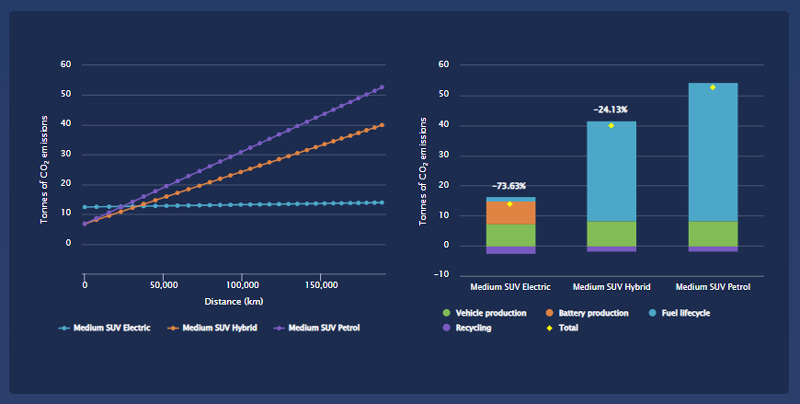

This website uses cookies to improve the user experience. We use cookies in accordance with our NRMA Group Cookie Policy.
This website uses cookies to improve the user experience. We use cookies in accordance with our NRMA Group Cookie Policy.

Known as the “Lifecycle Emissions Calculator,” the tool shows car emissions associated with all-electric, hybrid and petrol vehicles.
Looking at the entire lifecycle vehicle emissions is important, whether it is electric versus hybrid cars, or electric versus petrol, or even hybrid versus petrol.
Many are concerned that a transition to electric vehicles will not actually help curb climate change because the emissions associated with the manufacture of lithium-ion batteries are higher than for the production of internal combustion engines (ICE).
However, the tool shows that emissions from electric cars are better placed to help reduce greenhouse gas emissions because over the lifetime of the vehicle are in fact less than for hybrid and petrol cars.
To ensure a fair comparison between all types of vehicles, the tool considers the following:

The EVC says that it has taken a conservative approach to present worst-case scenarios for EVs. For instance, it assumes that EVs sold in Australia are predominantly from China, using grid average electricity with higher emissions.
It also assumes an average generation mix over the vehicle's life, without factoring in optimised renewable energy use by EV owners. Drivers can select if they buy 100% green energy or have rooftop solar panels that they could use to reduce emissions by charging during the day (or at night if they have a battery.)
For example, comparing a medium-sized all-electric SUV against a medium-sized hybrid SUV and a petrol-powered medium SUV, the tool shows the emissions are greater for the all-electric at time of manufacture.

However, the picture changes dramatically after the vehicles have been driven around 50,000km. After 200,000km, the CO2 emissions associated with the pure electric vehicle (121g/km) are more than half that of the petrol (279g/km,) and almost half that of the hybrid (211gm/km.)

The Lifecycle Emissions Calculator tool allows users to select their state or territory and compare different cars across segments and powertrains.
It provides data on carbon dioxide (CO2) emissions per kilometre and total cumulative emissions in tons of CO2 across the vehicle's lifecycle.
The results clearly demonstrate that EVs, even under conservative assumptions, have significantly lower lifecycle emissions than both hybrids and petrol vehicles.
You can try the Lifecycle Emissions Calculator for yourself here.